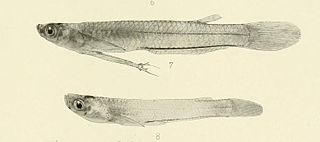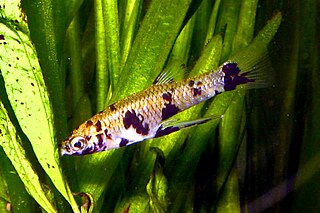
The Poeciliidae are a family of freshwater fishes of the order Cyprinodontiformes, the tooth-carps, and include well-known live-bearing aquarium fish, such as the guppy, molly, platy, and swordtail. The original distribution of the family was the Southeastern United States to north of Río de la Plata, Argentina, and Africa, including Madagascar. Due to release of aquarium specimens and the widespread use of species of the genera Poecilia and Gambusia for mosquito control, though, poeciliids can today be found in all tropical and subtropical areas of the world. In addition, Poecilia and Gambusia specimens have been identified in hot springs pools as far north as Banff, Alberta.

The Percidae are a family of ray-finned fish, part of the order Perciformes, which are found in fresh and brackish waters of the Northern Hemisphere. The majority are Nearctic, but there are also Palearctic species. The family contains more than 200 species in 11 genera. The perches, and their relatives are in this family; well-known species include the walleye, sauger, ruffe, and three species of perch. However, small fish known as darters are also a part of this family.
The Mastacembelidae are a family of fishes, known as the spiny eels. The Mastacembelids are part of the Order Synbranchiformes, the swamp eels, which are part of the Actinopterygii.

Caranginae is a subfamily of ray-finned fish from the family Carangidae which consists of twenty genera and 103 species.

Goodeinae is a subfamily of splitfins from Mexico, part of the family Goodeidae. They are small fish which mostly live in fresh water, especially around Mesa Central, west of Mexico City. Members of the subfamily are also found in brackish water on both the east and west coasts. They typically have small ranges and many are seriously threatened. The subfamily takes its name from its type genus Goodea and so is ultimately named after the American ichthyologist George Brown Goode (1851-1896).

Tomeurus gracilis is a species of poeciliid fish native to South America, in Brazil, Surinam and Venezuela. This species grows to a length of 3.3 centimetres (1.3 in) TL. It is the only known member of its genus. This specie sis classified in the tribe Cnesterodontini in the 5th edition of Fishes of the World. but other workers place it in its own tribe, the Tomeurini.

Poeciliinae is a subfamily of killifish from the family Poeciliidae which contains species from the Americas which are collectively known as the livebearers because many, but not all, of the species within the subfamily are ovoviviparous.

Squaliobarbinae is a small subfamily of the carp and minnow family, Cyprinidae, which consists of three monotypic genera which have their natural distributions in eastern Asia. Two species, the grass carp and the black carp, have been introduced to other parts of the world for weed control and aquaculture. They are large cyprinids which are characterised by an enlarged subtemporal fossa, the palate articulating with the supraethmoid, an enlarged intercalar bone in the cranial vault and a divided levator posterior muscle.

Procatopodinae is a subfamily of the family Poeciliidae, the "livebearers", in the order Cyprinodontiformes. Some authorities treat this subfamily as a family, the Procatopodidae, including the banded lampeye.

The Procatopodini is an African tribe of fishes, it is part of the subfamily Procatopodinae, within the family Poeciliidae.

The Heterandriini is a tribe of killifishes from the "livebearer" family Poeciliidae, consisting of seven genera and around 50 species. The tribe was originally delineated by Carl Leavitt Hubbs in 1924.

The Poeciliini is a tribe of killifishes from the "livebearer" family Poeciliidae, consisting of six genera and just over 100 species.

The Girardini is a tribe of killifishes from the "livebearer" family Poeciliidae, consisting of three genera and 10 species. The tribe was originally delineated by Carl Leavitt Hubbs in 1924.

Luciocephalinae is a subfamily of the gourami family Osphronemidae. The members of this subfamily differ from the other groups within the gourami family by having a reduced number of rays supporting the branchiostegal membrane, five rather than six, and in the possession of a median process of the basioccipital which reaches the first vertebra and which has an attachment to the Baudelot’s ligament.

Diploprionini is one of the five tribes in the subfamily Epinephelinae, the groupers, which is part of the family Serranidae which also includes the anthias and the sea basses.

Liopropomini is one of the five tribes in the subfamily Epinephelinae, the group including the groupers, which is part of the family Serranidae which also includes the anthias and the sea basses. They are found mainly in the Indo-Pacific region and in the Western Atlantic Ocean with a single species in the eastern Atlantic.

The Serraninae is a subfamily of perciform ray-finned fishes in the family Serranidae. It is made up of ten genera and 87 species.

The Luciopercinae is a subfamily of ray-finned fish, classified within the family Percidae, the subfamily includes the pike-perches and zingels. The pike-perches of the genus Sander have an Holarctic distribution while the zingels of the tribe Romanichthyini are found in Europe. They are largely freshwater species but some can be found in brackish water.

Romanichthyini is a tribe of freshwater ray-finned fish which is one of two tribes in the subfamily Luciopercinae, which in turn is classified under the family Percidae, the family also includes the perches, pikeperches, ruffes and darters.
Acanthuriformes is an order of ray-finned fishes, part of the Percomorpha clade. Some authorities place the fishes in the order within the Acanthuriformes in the suborders Acanthuroidea and Percoidea of the order Perciformes.

















